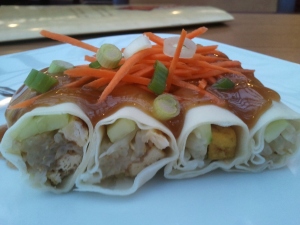If you’ve found this page, there’s no doubt you’ve experienced the textures and flavors of the famed Spam Musubi, and are looking to assemble your own.
The popular Hawaiian street-food and mock Sushi roll is said to date back to WWII and may have been born of necessity by Japanese prisoners held in internment camps. This theory holds merit in that Spam is an inexpensive salty meat with a long shelf life requiring no refrigeration that could be distributed over long distances by the US army to its soldiers and prisoners.
Regardless of its origin Spam Musubi is an excellent snack for anyone longing to experience sunshine, travel, and exotic flavors.
To get started you’ll find an ingredient list below including optional items, preparation instructions, and some commentary on these instructions to keep you focused as you wind your way through the process of homemade Spam Musubi.
Musubi Ingredients:
3 cups of steamed white rice (short grain)
1 can of Spam (7 or 12 oz.)
Nori (Roasted Seaweed) Sushi Paper
Soy-Teryaki Sauce (recipe for homemade below)
1 Musubi Mold (or 7 oz. Spam Can, see commentary below)
* Optional: Furikake Rice Seasoning, Sushi Powder Vinegar
** You will also need a small to medium pot, and a baking sheet or frying pan.
– – –
Soy Teryaki Glaze Ingredients: equal parts sugar, water and shoyu (or soy sauce).
* Optional: 1-2 tbsp Corn Starch, Sesame Oil
First time? A third cup of each, and experiment with your quantity needs in future iterations.
How to Prepare Your Ingredients
- Rice. Prepare 2-3 cups of white rice, preferably using a rice maker, yielding roughly 4-6 cups of cooked rice. Rice steaming takes 35 – 45 minutes depending on your device and tenderness preference, giving you ample time to prepare all the other parts of your Musubi.
- Nori. Using a clean kitchen scissors, cut your Nori roasted seaweed sheets in half, to the width of your Musubi mold, or Spam can, then set aside.
- Spam. Empty your Spam onto a cutting board, and slice into thick even pieces. You should be able to produce eight slices from a 12 ounce can by cutting the block(s) in half continuously and as congruently as possible.
- Preheat Oven. Line a baking sheet (the smaller the better) with tin foil, and lay your spam, then preheat your oven to 450 or 500 degrees.
- Soy-Teriyaki Glaze. In a small or medium pot stir to combine equal parts water, sugar and shoyu (or soy sauce) over medium or medium-low heat. If the mixture is too runny for your taste, add corn starch to thicken starting with a half or full tablespoon. Set aside, allowing to cool, but do not refrigerate.
- Bake Spam. 6 – 10 minutes in your oven to desired state of browning and roast.
Preparing your Spam Musubi Rolls
With all of your ingredients ready to assemble, I recommend having them within arms reach in order to assemble the rolls as fluidly and systematically as possible. Have a plate, cutting board, or smooth clean surface you can work on to form your Musubi.
- Place slice of Nori in front of you, in any direction, and place the mold or Spam can perpendicular across the Nori.
- Scoop a modest portion of steamed rice into the mold onto the Nori paper, and press firmly using the lid to your mold, or a spoon.
- At this point it is a popular custom to sprinkle the rice with a light dusting of Furikake rice seasoning.
- Dip or otherwise coat a slice of oven roasted Spam in Teriyaki and place in the mold atop the first layer of rice.
- Scoop a similar portion of rice on top of the Spam and press firmly on the rice using a spoon or the lid to your mold.
- Pressing the lid of your mold down firmly on the layers of Musubi, slide the mold upward to remove it from the roll, then lift away your lid.
- Wrap one end of your Nori over the roll as tightly as you can, then wrap the other end over. The moisture of the rice will cause the wrap to wilt slightly helping the wrapper to adhere.
- Dip the spoon or the tip of your finger into the Teriyaki and spread it lightly where the Nori overlaps as an adhesive to seal the wrap.
- Set aside your completed roll and repeat until you have used all of your Spam.
Recipe Commentary.
- Rice 1. Once your rice is ready I would recommend scooping 3 – 4 cups into a bowl, or removing the steaming pot from the steamer to cool slightly. Rice out of the steamer is very hot and can burn your fingertips when it comes time to wrapping the roll.
- Rice 2. Since Musubi is considered a “sushi roll” you may want to prepare sushi rice. Normally sushi rice is typically prepared by adding some rice vinegar to the steamed rice. This comes in liquid or powdered form. Hawaiians typically lean toward the powdered for its convenience, and inexpensive price tag. You decide. I normally do not add the vinegar, working solely with the steamed white rice.
- Spam. Another popular method for preparing the Spam is to fry it in a pan. Some will even sauté the Spam with their Teriyaki. I prefer the oven because it is hands off, and relatively low mess. It frees me up to focus my attention on the Soy-Teriyaki glaze.
- Soy-Teriyaki Glaze 1. I add 1 – 2 tbsp of cornstarch to my glaze to thicken it slightly. Before adding I will sift the corn starch once or twice through a kitchen sieve to keep it from lumping. And sometimes I combine the corn starch with 1-2 tbsp of water so it is dissolved before I add it to the glaze mixture in the pot. Stir a few times and wait for it to thicken.
- Soy-Teriyaki Glaze 2. The mixture can go from simmer to boiling and sputtering very quickly, so I advise keeping an eye on it from start to finish. Stirring and reducing the heat will help keep it from evaporating, and crusting up your pot. Remove from heat and let cool before assembling your Musubi roll.
- Soy-Teriyake Glaze 3. Another popular tip for this homemade recipe is to add a dash of Sesame Oil. It is an essential ingredient of Chinese cooking in general. Some people love it, some people hate it.
- Furikake. The popular Japanese rice seasoning comes in several varieties, take your pick. It is not a requirement of the recipe, but a popular addition. If not adding in assembling the roll, you can sprinkle or press the end of your roll into the seasoning for a textured effect.
- Musubi Mold 1. If you don’t have a Musubi Mold you can use a 7 oz Spam can as your mold. Your assembly results may be less consistent from roll to roll, but are equally as tasty. I recommend rinsing the can in water between rolls making it easy for the roll to remove the roll from the can each time. Warm rice and the teriyaki glaze will make things sticky from roll to roll.
- Musubi Mold 2. If you are using a Musubi mold or press I recommend rinsing the mold and lid between rolls to remove sticky residue from the warm rice and teriyaki glaze. Musubi molds come in several sizes and varieties, and are very inexpensive.
- Musubi Rolls. If you plan to slice your roll into bite sized pieces, I would recommend using a serrated knife as the wilted seaweed wrap is highly sensitive to tearing.
- Storing Rolls. Wrap rolls individually using clear plastic wrap and refrigerate up to 2 days. You can eat them cold from the refrigerator, or heat them up in the microwave in less than a minute.





